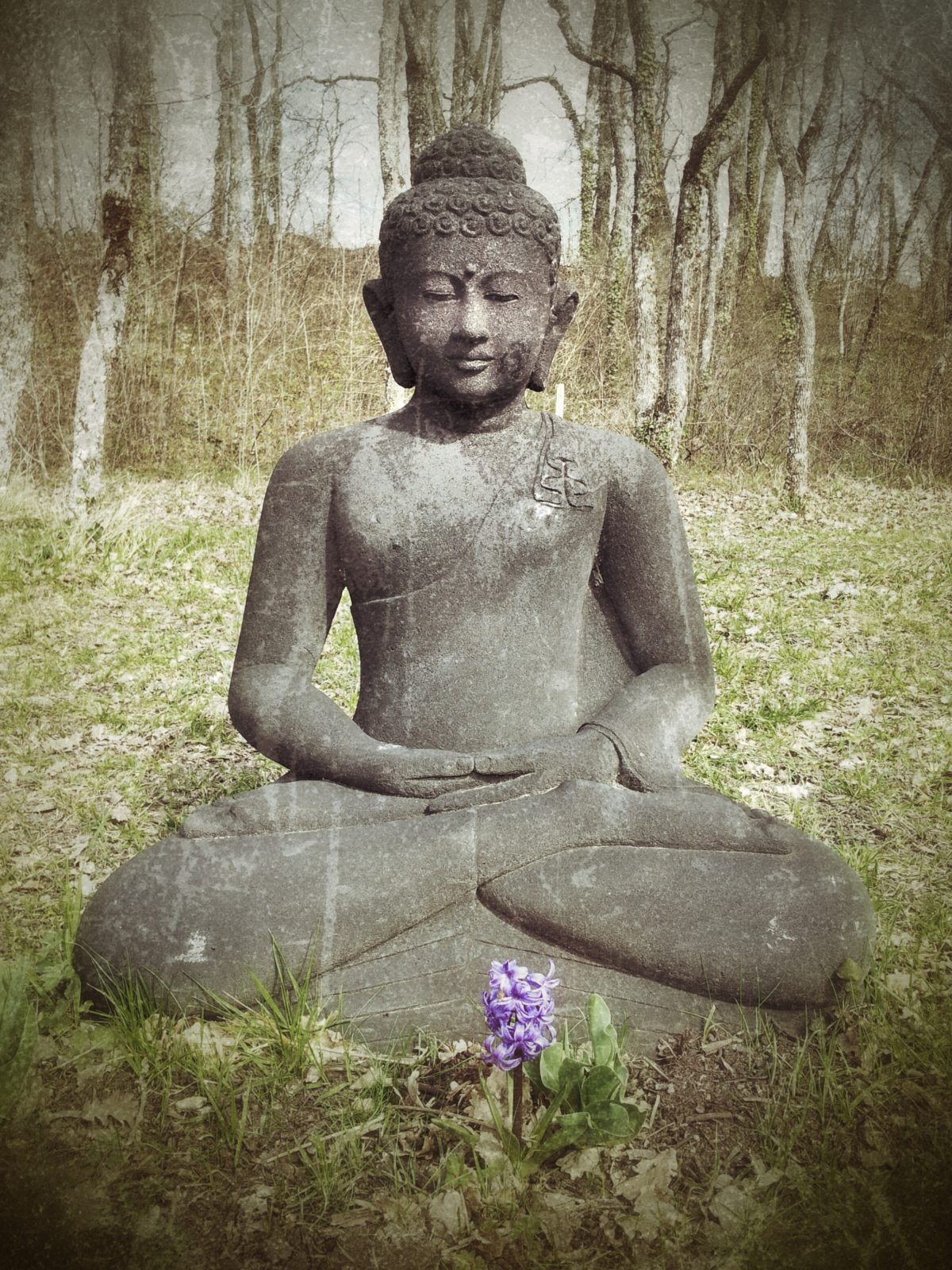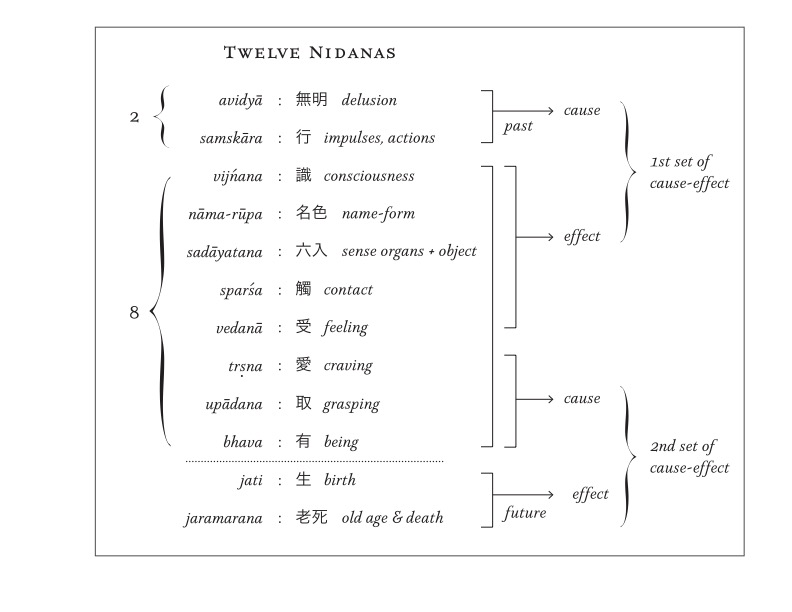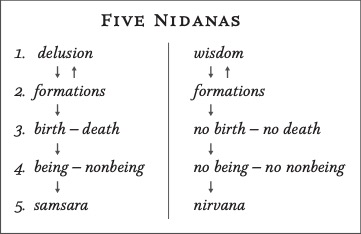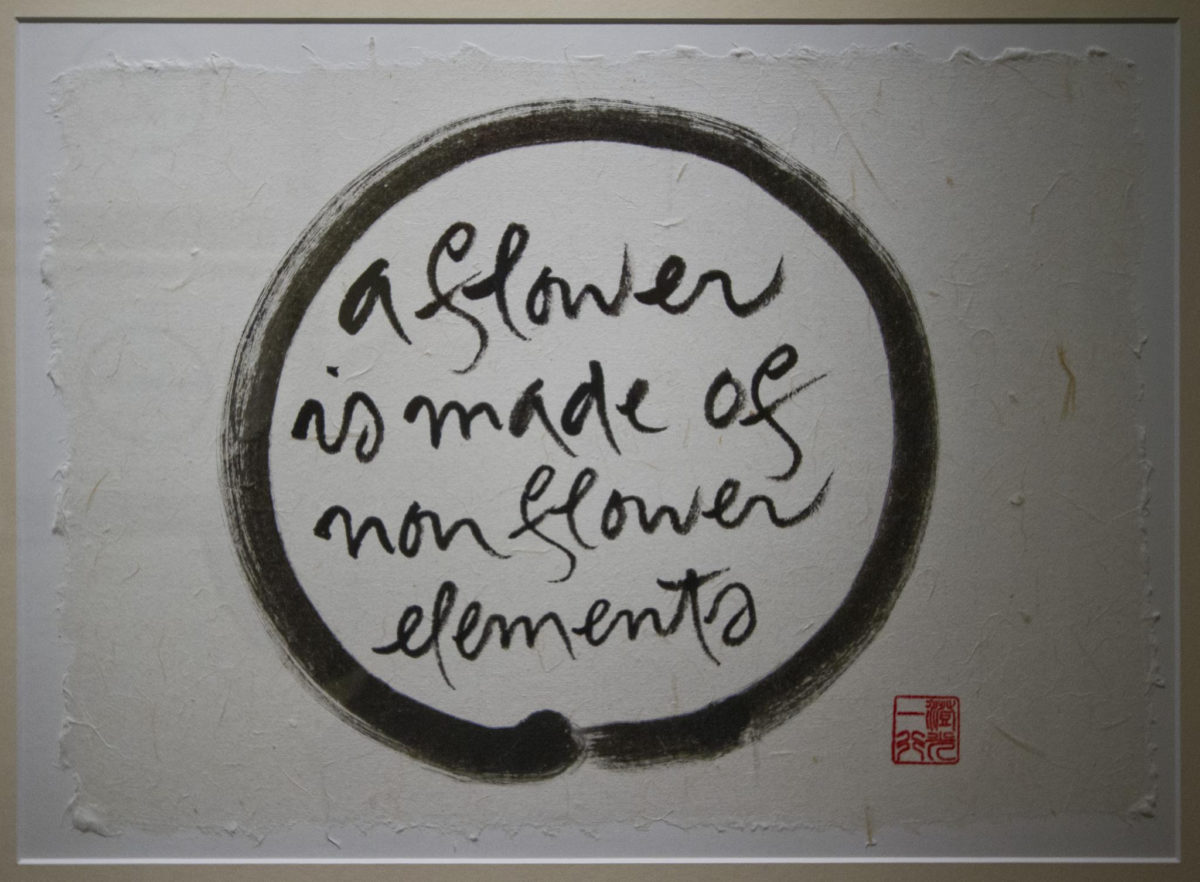
Editors’ note: This is Part II of the Dharma talk from November 29, 2012. Part I is available here.
We know that there is a dimension of reality called the historical dimension. We live in our time; we live in history. Therefore, in the historical dimension, we recognize birth and death, being and nonbeing, you and I, as different things.

Editors’ note: This is Part II of the Dharma talk from November 29, 2012. Part I is available here.
We know that there is a dimension of reality called the historical dimension. We live in our time; we live in history. Therefore, in the historical dimension, we recognize birth and death, being and nonbeing, you and I, as different things. The father is not the son. The father has one passport, the son has another passport. You cannot mix them. The left is not the right, the above is not the below. That is what happens in the historical dimension.
In the historical dimension, we see things as separate; they exist outside of each other. Father is outside of son. A cloud is outside a flower. That is what we call the conventional truth. The conventional truth is helpful; it works in the historical dimension. It’s like classical science represented by Newton. We can apply that kind of science in technology and so on.
But now we have another kind of science, quantum physics, that goes deeper, and we begin to discover another kind of truth. In quantum physics, things are quite different. In classical physics, a wave can only be a wave; it cannot be a particle. But in quantum physics, a wave can be a particle and a particle can be a wave. And a particle can be everywhere at the same time, not just in one place. Its nature is non-local. So this other kind of science seems to contradict the truth seen in the historical dimension.
In meditation, we also see two kinds of truth. We see the conventional truth, but if we look deeper, we can see differently. We see that the cloud is not outside of the flower and the father is not outside of the son. Looking deeply into the son, you see the father. There is a way of practice that leads us from the historical dimension to the ultimate dimension.
In the ultimate dimension, we touch the ultimate truth, where you cannot take the left out of the right, where you cannot take the father out of the son, because things inter-are. In order to understand, to touch this ultimate dimension, we have to learn how to release the notions that we use in conventional truth.
What the Buddha said concerning the genesis of the world is very simple. He did not say that the world is created by God. He said that the world comes into being because of the interconnection between things. He said: This is because that is. So simple. This is the teaching of genesis in Buddhism.
In Plum Village we have a simple image to illustrate this: the left and the right sides of a sheet of paper. The left cannot be by itself alone. The left has to lean on the right in order to be. The right has to lean on the left in order to be. They are connected. Without the left, there is no right; without the right, there is no left. This is because that is. The same is true with above and below, father and son, and flower and cloud. Everything.
The Buddha taught that in the historical dimension, we follow the principle of identity: “A” is only “A,” it cannot be “B.” He used the notions of the historical dimension to lead us slowly into the ultimate dimension. That is skillful means. We begin by believing this is not that. But the Buddha slowly shows us that this is in that. He uses the notion of this and that to lead us to a dimension where this and that are one, are inside of each other. The notion of being and nonbeing can be removed. This is the teaching of conditioned genesis, the teaching of inter-arising, of co-arising.
This teaching uses notions and concepts to help us release notions and concepts. It has the power to connect us with ultimate truth. The teaching has to be careful, leading us slowly to the ultimate dimension. In this way it can connect us with the ultimate truth.

Interbeing
In the ultimate truth, we use words like “emptiness.” “Emptiness” is an expression that is equivalent to “God.” God is the ultimate, emptiness is the ultimate. Emptiness is the absence of notions and concepts. You cannot describe God with notions and concepts. You cannot say that God is or is not. To say that God exists is nonsense, to say that God doesn’t exist is nonsense, because notions of being and nonbeing cannot be applied to the ultimate. The notion of being and nonbeing can be used in the historical dimension, but not in the ultimate dimension. We need some skillfulness to move from the historical to the ultimate. The term “interbeing” is skillful, because it still uses the word “being,” but it helps us to get out of the notion of being.
To get out of the notion of being and nonbeing, you use the insight of interbeing. Nothing can be by itself alone. Everything has to inter-be with everything else. So the notion of interbeing, although it is a notion, helps to lead you to the ultimate truth. It helps you to be connected with emptiness. Interbeing means you cannot be by yourself alone; this is because that is. You can only inter-be. Interbeing is a kind of notion that can help you get the insight that will free you from the notion of being and nonbeing. Interbeing can connect the conventional truth to the ultimate truth, so it can lead you to emptiness.
Sunyatapratisamyukta. Pratisamyukta is “connected with.” Sunyata is “emptiness.” Connected with emptiness. There is a kind of wisdom called wisdom of adaptation, or wisdom of conformity, that helps you to connect with emptiness. This wisdom is the insight into interbeing or conditioned genesis. With this insight, you are on the way that can lead you to the ultimate truth. You need the wisdom of adaptation because this teaching can help you conform and be connected with the ultimate truth. So the Buddha and the patriarchs deliver the teaching on interbeing that can adapt and connect you with the ultimate truth represented by emptiness.
Restoring the Meaning of the Nidanas
The teachings of the twelve nidanas, or twelve links, presented in many sutras do not seem to help us connect with the ultimate truth. They belong to the category of conventional truth. They aim more at explaining samsara, reincarnation. That is why we have to restore the nidanas so they will lead us to the ultimate truth. Instead of twelve nidanas, we can use five nidanas; that is enough.
The twelve nidanas begin with avidya, which is ignorance, delusion. Delusion is the better word. According to this teaching, avidya gives rise to samskara, which has been translated as “impulses,” “action,” or “disposition.” Action, here, is like karma. With karma, there are three kinds of action: action by the body, action by the mouth, and action by the mind. So avidya, delusion, gives rise to wrong action, wrong impulses, the kind of energy that is blind and that will bring suffering.
Then because of samskara, there is vijnana, consciousness. Based on consciousness, there will be body and mind, nama-rupa: name-form. Name means mind, form means body. Because we have body and mind, we have six sense organs and their objects. Sadayatana, sense organ and object. Mental consciousness is one of the six. Because we have the sense organs and their objects, we have contact, sparsa. Contact, touch.
Because of contact, there will be feeling, vedana. Because there is feeling, there is attachment, trsna. Craving. Because you have craving, you are caught. Upadana. Grasping. Because there is grasping, there is existence. Bhava. Being. Because there is being, you have to be born, jati. And to suffer samsara, reincarnation. Because you are born, you have to grow old and die, jaramarana.
So that is the classical way of presenting the nidanas. But as we study Buddhism, we hear the Buddha speaking of nidanas in different ways. Sometimes he says there are only three, sometimes four, sometimes five, sometimes six. Twelve is only one of the ways to explain co-arising, interconnection.
When Thay was a student in the Buddhist Institute, he learned that these twelve links represent three times and two layers of cause and effect. The first two links, the first two nidanas, belong to the past. For example, in a former life I became deluded and did many actions, so I had to be reborn into this life. This life is represented by eight nidanas: consciousness, name-form, sense organs, contact, feeling, craving, grasping, being. After this body disintegrates, I will continue with the next life; I will be born again and die again. It’s very clear that the twelve nidanas, when taught in this way, aim to explain reincarnation, rebirth, but are not aiming to help us touch the ultimate dimension.
As a student, I also learned that there are two layers of cause and effect. What I have done in the past is the cause: the effect of those actions is this consciousness, this body and mind, these six organs, this contact, and these feelings. Because of the deluded actions in the past, I had to inherit all this. This is the first layer of cause and effect. Because I produce craving and grasping, and create being, these three nidanas serve as cause again, which will lead to the effect of birth and death in the future. This is the second layer.
This is the teaching of three times and two layers of cause and effect. As a student, I believed my teacher and I accepted the teaching, but as I continued to learn and to practice, I found that this teaching can be used only on the level of conventional truth. It is not Buddhism at its best, because its aim is not to lead us to ultimate truth, but only to explain the mechanism of rebirth.
Correcting Misinterpretations of the Buddha’s Teachings
Thay has found many problems with the traditional interpretation of the Buddha’s teaching. The first problem is that we have to understand the word “samskara” differently. The basic meaning is “formation.” “Samskara” means phenomena, things. A flower is a samskara. A tree is a samskara. A body is a samskara. Anger is a samskara. Anything that relies on everything else to express itself is a samskara. That is why the word “formation” is a very good English translation of “samskara.”
We know that all formations are impermanent. The flower is a formation because it is made only of non-flower elements. The non-flower elements have come together and produced the flower. The flower has no private essence, no nature of its own. Its existence depends entirely on non-flower elements, and if you remove any of the non-flower elements, the flower cannot be. A flower is a formation. The same thing is true with a cloud, with a human being, with a tree, with everything. Everything we see is a formation. That is the actual meaning of the word “samskara.”
Because of our ignorance, we see formations as having a separate existence, as having their own nature. We see formations as existing outside of each other, independently. The world we are observing in us and around us is the world of our mental construction rather than the world of reality itself. We don’t see samskara as they truly are. So samskara are formations, understood as selves and dharmas, as things that exist by themselves, having their own true nature, and they exist outside of each other. We see things that way because of delusion.
In the case of an enlightened being, a buddha or a bodhisattva, delusion is transformed, and when the darkness is removed, the light is there. So in the case of the Buddha, instead of having avidya, he has vidya—wisdom, or insight. He still sees samskara, formation, but when he looks at a flower, he sees the flower in the light of interconnection, inter-arising, co-arising. He sees the flower not as its own self, or as something that can exist by itself. He can see all things, all formations, as they are: namely, without self, without permanence.
We also see samskara, but we see a formation as permanent, as having a self which exists separately from other formations. So there are two ways of looking at samskara, the enlightened way and the deluded way.
Because we see samskara as having true nature, we solidify our delusion; and because of our delusion, we see formations as having separate existence, self, and permanence. Samskara, for us, is having a self and an own nature; samskara, for the Buddha, does not have self or its own separate nature. That is the difference between delusion and wisdom.

The Five Skandhas Are Not of Themselves Suffering
The second weakness of this presentation is that if we have craving, grasping, and attachment to being, we blame our five skandhas as the cause. It is taught that because we have a consciousness, a body and mind, six sense organs, contact, and feelings, we have craving and gasping and being. This is the second set of cause and effect.
But look at a Buddha. He also has consciousness, he also has body and mind. He also has six sense organs, contact, and feeling. But why doesn’t he have craving? We have craving and aversion, like and dislike. When you like this world, you want to survive. When you hate this life, you want to commit suicide. So you crave for being or you crave for nonbeing. Those who suffer so much, who do not like to be alive, they also have a craving—craving for nonbeing, very tempting sometimes.
A buddha has all these links, but he can produce freedom, non-attachment, compassion, loving kindness. So you cannot blame your body and mind for your afflictions. That is the second shortcoming of the teaching.
When I see the suffering all around me, if I have mindfulness and concentration, I allow myself to get in touch with the suffering, and I allow compassion and loving kindness to be born. These are very good things to allow to develop. That is why to say that contact and feelings can only bring craving and grasping is not true. It can bring enlightenment, it can bring understanding, it can bring love. That is why the traditional teaching on the twelve nidanas aims only at explaining reincarnation, samsara, transmigration, and can be used only on the level of the conventional truth. It does not belong to the set of teachings and practice that can be adaptive and connected with the ultimate truth.
So you have delusion. You look at a formation and you don’t see its true nature. You see formations as having a self, as being permanent, as existing outside of each other. When you see formations in that way, as things that exist outside of each other, you think that they have a beginning and end, that there is birth and death. However, when you contemplate a cloud, you see that it is not possible for a cloud to die. To die means that from something you become nothing, and that is not the case of the cloud. A cloud cannot become nothing. A cloud can become snow or rain, or ice, but it’s impossible for a cloud to die.
With wisdom, the Buddha looked at formations and saw that their true nature is the nature of no-birth and no-death. If you touch the nature of no-birth and no-death in a formation, you are truly seeing that formation as it is. Science is capable of finding no-birth and no-death. The first law of thermodynamics, the law of the conservation of matter and energy, tells us that the nature of matter and energy is no-birth and no-death. You cannot create matter; you cannot destroy matter. You cannot create energy; you cannot destroy energy. You can only transfer matter into energy, energy into another kind of energy, or energy into matter. But you do not have the power to create new matter, or to destroy energy. In this way, physicists, chemists, scientists can understand the nature of no-birth and no-death.
In the realm of meditation, if we look deeply with mindfulness and concentration, we can see the nature of no-birth and no-death of a cloud. A cloud hasn’t come from nothing, from nonbeing; a cloud has come from steam or from water.
The notion of birth and death always goes along with the notion of being and nonbeing. The shortcoming of this presentation is to blame suffering on being. But how can being be possible without nonbeing? So being, here, should be understood as being and nonbeing. In fact, we suffer not because of being, but because of the notion of being and the notion of nonbeing. Contact and feelings can bring either craving or aversion, or compassion or freedom. It depends on how we use the sense organs and contact.
So the traditional presentation is not complete. Contact and feeling can give rise to grasping, but also to releasing and freedom. We suffer because we cling to the notion of being and nonbeing; either we are afraid of being or we are afraid of nonbeing. But with wisdom, not only are you free from the notion of birth and death, you are also free from the notion of being and nonbeing. No being, no nonbeing.
In the historical dimension, to be or not to be is the question, but in the ultimate dimension, to be or not to be is no longer the question. You are free from both notions, and there is no fear anymore. You are not drowned in the waves of birth and death, being and nonbeing. You are free, and that is nirvana. Nirvana is perfect freedom, because you see formations as they truly are. And the true nature of these formations is no-birth and no-death, no being and nonbeing. With that kind of insight you enjoy nirvana, without fear, without craving.
But with delusion, you see formations as self and as permanent. You see them in the light of birth and death, being and nonbeing. That is why you navigate always in the realm of samsara.
So we need only five nidanas:
- delusion/wisdom
- formations
- birth–death/no birth–no death
- being–nonbeing/no being–no nonbeing
- samsara/nirvana
Five nidanas. If you don’t have delusion, then you see formations as they really are, and then you don’t see birth and death anymore. You are not caught in the notion of being and nonbeing anymore, and you get out of samsara: you are in nirvana. You don’t have to go to nirvana, nirvana is right there. Nirvana is already, since the non-beginning.
With some skillfulness, we can always begin here on the level of the conventional truth. With that skillfulness, we slowly get out of the conventional realm of truth. We use the wisdom of adaptation, we use the wisdom of conformity, to see the nature of reality, and to help people to slowly get out of these notions and concepts using the Middle Way. The Middle Way helps you to be free from pairs of opposites, birth and death, being and nonbeing, inside and outside, object and subject, and so on.
It will be very interesting if scientists of our time learn how to go the Middle Way, because many of them are still asking questions like, “What is the cause of the universe, the cosmos? Why is there something rather than nothing? Why?” So they are still caught in these notions of beginning, ending, being, and nonbeing. The wisdom of adaptation, the wisdom of conformity, help us to practice and to offer the practice in a way that helps us to be connected with the ultimate dimension presented by emptiness.

EDITED BY BARBARA CASEY AND SISTER ANNABEL, TRUE VIRTUE


